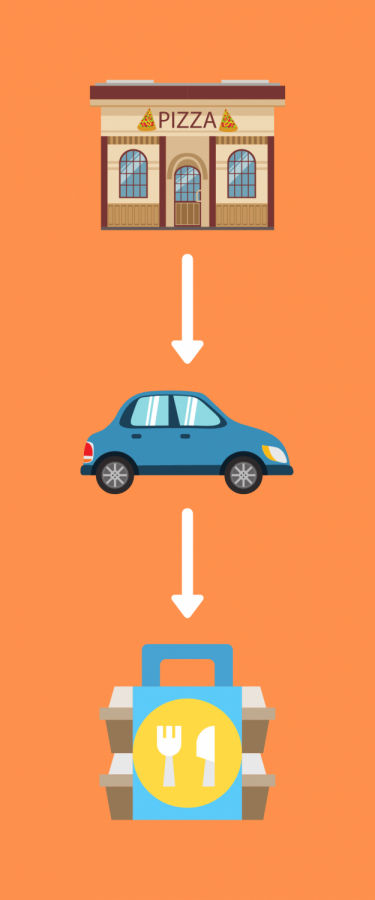An Environmentally Friendly Food Delivery Service Emerges: DeliveryZero
It is projected that global revenue from online food delivery will reach $200 billion by 2025. Staff image: Ella Hartmanis.
March 29, 2021
Third-party delivery services, such as DoorDash and UberEats, provide an easy option for people to get their meals hassle-free. The usage of such services has increased during the COVID-19 pandemic as many businesses have turned to take out as an option to survive. Depending on county restrictions, restaurants have been limited to takeout and outdoor dining at a limited capacity for months.
DoorDash, UberEats, Grubhub and Postmates generated approximately $5.5 billion in combined revenue from April to September of 2020, which is more than twice as much as their combined revenue during that period in 2019, according to Market Watch. However, one major issue with the food takeout industry is its impact on the environment.
The average delivered meal uses 2.8 single-use plastic items, which is about 54 grams of plastic, while a restaurant meal uses an average of 6.6 grams of plastic, according to EcoWatch. According to Business Wire, in 2019 it was projected that global revenue from online food delivery will reach $200 billion by 2025, which has likely increased considering this was projected prior to the pandemic.
Sophomore Madison Vitro uses DoorDash about once every one to two weeks because it is a convenient option for meals when her family doesn’t want to prepare food or would rather order from a specific restaurant. “One of the main reasons I think DoorDash is so popular is because it has so many restaurant options and you can get it so easily by just tapping a couple of buttons,” Vitro said.
A new third-party delivery service is taking a different approach to takeout: reusable containers. DeliverZero, a New York City company, uses reusable containers that can either be directly returned to any participating restaurant or given to the delivery drivers after the user orders through the platform again. These containers are then returned to the restaurants, washed and ready to be used for another delivery. According to Fast Company, the platform launched in November 2019 and now has more than 100 participating restaurants. As of January 2021, DeliverZero was also adding five to ten new restaurants to its services weekly.
The containers are made of BPA-free polypropylene plastic and have a lifetime of about 1,000 uses. Furthermore, according to DeliverZero, customers are given six weeks to return the containers, and if they don’t return them during that time frame they are charged $3.25 plus tax for each of the containers they keep. Although DeliveryZero is currently only in New York City, the company has plans to expand in the following year to more cities such as Chicago. While DeliveryZero does not yet have plans to offer their service in California, they are already making a tangible difference in New York City.
“I feel like I would be interested in reusable containers, but realistically, I don’t think that would fully replace DoorDash because one of the luxuries that come with DoorDash is that it is easy on the go and convenient. But it sounds like an innovative idea for the environment, so if you are just trying to avoid cooking [by ordering takeout], it would be a more sustainable idea,” Vitro said.
Freshman Jake Sonsini’s family uses DoorDash about once a week, and he shared his opinion on a delivery service with reusable containers as well. “I think it would be a good option but probably after COVID since people are pretty cautious right now with reusable materials,” Sonsini said.
Another rising business in the food sector is meal kit delivery services. Meal kits have pre-portioned and packaged ingredients that people can then prepare in their residence. Like takeout, much of the food is delivered in plastic containers and other various types of packaging, but is it truly worse for the environment than going to the grocery store to buy ingredients yourself? Short answer: No. A study conducted by Science Direct gathered data comparing the overall environmental impacts of meal kits versus grocery store meals based on greenhouse gas and transport emissions, food loss and waste and packaging. The study found that on average, grocery meal greenhouse gas emissions are 33% higher than meal kits since a majority of the reduced emissions stem from less food waste and a more streamlined supply chain.












